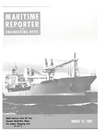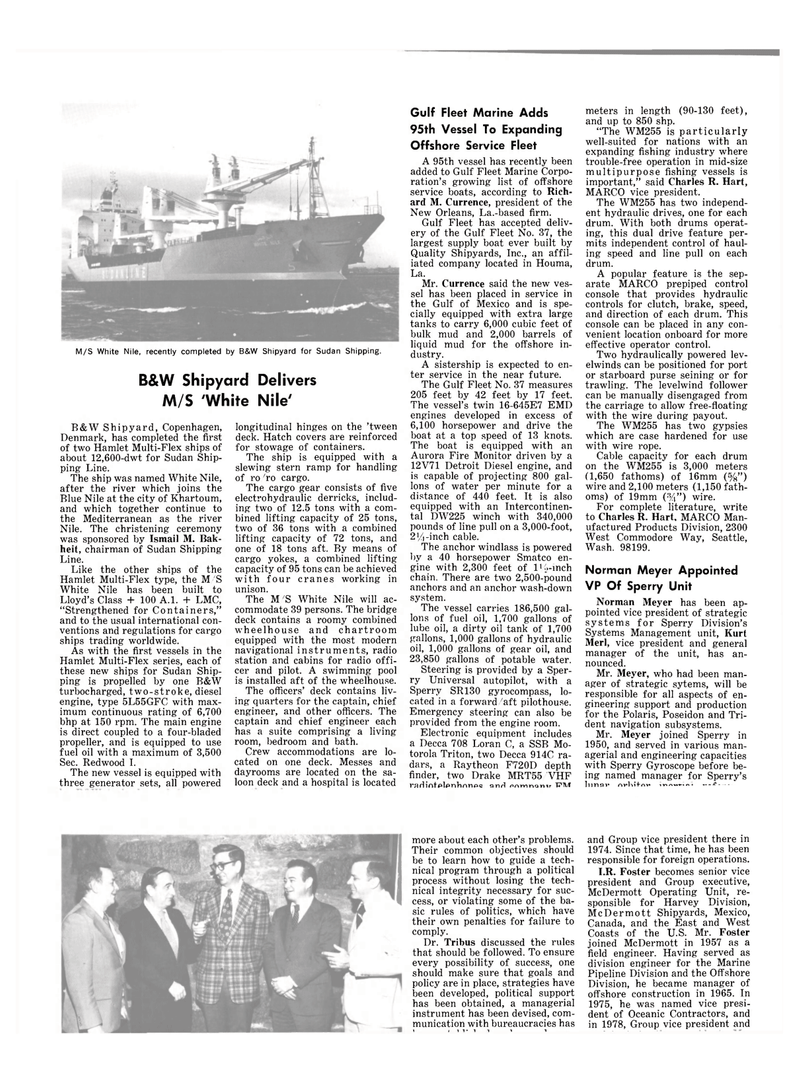
Page 6: of Maritime Reporter Magazine (March 15, 1980)
Read this page in Pdf, Flash or Html5 edition of March 15, 1980 Maritime Reporter Magazine
M/S White Nile, recently completed by B&W Shipyard for Sudan Shipping.
B&W Shipyard Delivers
M/S 'White Nile7
B&W Shipyard, Copenhagen,
Denmark, has completed the first of two Hamlet Multi-Flex ships of about 12,600-dwt for Sudan Ship- ping Line.
The ship was named White Nile, after the river which joins the
Blue Nile at the city of Khartoum, and which together continue to the Mediterranean as the river
Nile. The christening ceremony was sponsored by Ismail M. Bak- heit, chairman of Sudan Shipping
Line.
Like the other ships of the
Hamlet Multi-Flex type, the M S
White Nile has been built to
Lloyd's Class + 100 A.l. + LMC, "Strengthened for Containers," and to the usual international con- ventions and regulations for cargo ships trading worldwide.
As with the first vessels in the
Hamlet Multi-Flex series, each of these new ships for Sudan Ship- ping is propelled by one B&W turbocharged, two-stroke, diesel engine, type 5L55GFC with max- imum continuous rating of 6,700 bhp at 150 rpm. The main engine is direct coupled to a four-bladed propeller, and is equipped to use fuel oil with a maximum of 3,500
Sec. Redwood I.
The new vessel is equipped with three generator sets, all powered longitudinal hinges on the 'tween deck. Hatch covers are reinforced for stowage of containers.
The ship is equipped with a slewing stern ramp for handling of ro/ro cargo.
The cargo gear consists of five electrohydraulic derricks, includ- ing two of 12.5 tons with a com- bined lifting capacity of 25 tons, two of 36 tons with a combined lifting capacity of 72 tons, and one of 18 tons aft. By means of cargo yokes, a combined lifting capacity of 95 tons can be achieved with four cranes working in unison.
The M/S White Nile will ac- commodate 39 persons. The bridge deck contains a roomy combined wheelhouse and chartroom equipped with the most modern navigational instruments, radio station and cabins for radio offi- cer and pilot. A swimming pool is installed aft of the wheelhouse.
The officers' deck contains liv- ing quarters for the captain, chief engineer, and other officers. The captain and chief engineer each has a suite comprising a living room, bedroom and bath.
Crew accommodations are lo- cated on one deck. Messes and dayrooms are located on the sa- loon deck and a hospital is located
Gulf Fleet Marine Adds 95th Vessel To Expanding
Offshore Service Fleet
A 95th vessel has recently been added to Gulf Fleet Marine Corpo- ration's growing list of offshore service boats, according to Rich- ard M. Currence, president of the
New Orleans, La.-based firm.
Gulf Fleet has accepted deliv- ery of the Gulf Fleet No. 37, the largest supply boat ever built by
Quality Shipyards, Inc., an affil- iated company located in Houma,
La.
Mr. Currence said the new ves- sel has been placed in service in the Gulf of Mexico and is spe- cially equipped with extra large tanks to carry 6,000 cubic feet of bulk mud and 2,000 barrels of liquid mud for the offshore in- dustry.
A sistership is expected to en- ter service in the near future.
The Gulf Fleet No. 37 measures 205 feet by 42 feet by 17 feet.
The vessel's twin 16-645E7 EMD engines developed in excess of 6,100 horsepower and drive the boat at a top speed of 13 knots.
The boat is equipped with an
Aurora Fire Monitor driven by a 12V71 Detroit Diesel engine, and is capable of projecting 800 gal- lons of water per minute for a distance of 440 feet. It is also equipped with an Intercontinen- tal DW225 winch with 340,000 pounds of line pull on a 3,000-foot, 2]/Hnch cable.
The anchor windlass is powered by a 40 horsepower Smatco en- gine with 2,300 feet of 1 Mm rich chain. There are two 2,500-pound anchors and an anchor wash-down system.
The vessel carries 186,500 gal- lons of fuel oil, 1,700 gallons of lube oil, a dirty oil tank of 1,700 gallons, 1,000 gallons of hydraulic oil, 1,000 gallons of gear oil, and 23,850 gallons of potable water.
Steering is provided by a Sper- ry Universal autopilot, with a
Sperry SR130 gyrocompass, lo- cated in a forward aft pilothouse.
Emergency steering can also be provided from the engine room.
Electronic equipment includes a Decca 708 Loran C, a SSB Mo- torola Triton, two Decca 914C ra- dars, a Raytheon F720D depth finder, two Drake MRT55/VHF
V^rlintplpnVinnpG onrl r*r\mr-iQr»ir TTTX/r meters in length (90-130 feet), and up to 850 shp. "The WM255 is particularly well-suited for nations with an expanding fishing industry where trouble-free operation in mid-size multipurpose fishing vessels is important," said Charles R. Hart,
MARCO vice president.
The WM255 has two independ- ent hydraulic drives, one for each drum. With both drums operat- ing, this dual drive feature per- mits independent control of haul- ing speed and line pull on each drum.
A popular feature is the sep- arate MARCO prepiped control console that provides hydraulic controls for clutch, brake, speed, and direction of each drum. This console can be placed in any con- venient location onboard for more effective operator control.
Two hydraulically powered lev- elwinds can be positioned for port or starboard purse seining or for trawling. The levelwind follower can be manually disengaged from the carriage to allow free-floating with the wire during payout.
The WM255 has two gypsies which are case hardened for use with wire rope.
Cable capacity for each drum on the WM255 is 3,000 meters (1,650 fathoms) of 16mm (%") wire and 2,100 meters (1,150 fath- oms) of 19mm (%") wire.
For complete literature, write to Charles R. Hart, MARCO Man- ufactured Products Division, 2300
West Commodore Way, Seattle,
Wash. 98199.
Norman Meyer Appointed
VP Of Sperry Unit
Norman Meyer has been ap- pointed vice president of strategic systems for Sperry Division's
Systems Management unit, Kurt
Merl, vice president and general manager of the unit, has an- nounced.
Mr. Meyer, who had been man- ager of strategic sytems, will be responsible for all aspects of en- gineering support and production for the Polaris, Poseidon and Tri- dent navigation subsystems.
Mr. Meyer joined Sperry in 1950, and served in various man- agerial and engineering capacities with Sperry Gyroscope before be- ing named manager for Sperry's lliripv nvKifrtv —f more about each other's problems.
Their common objectives should be to learn how to guide a tech- nical program through a political process without losing the tech- nical integrity necessary for suc- cess, or violating some of the ba- sic rules of politics, which have their own penalties for failure to comply.
Dr. Tribus discussed the rules that should be followed. To ensure every possibility of success, one should make sure that goals and policy are in place, strategies have been developed, political support has been obtained, a managerial instrument has been devised, com- munication with bureaucracies has i i i i • T 1 i t and Group vice president there in 1974. Since that time, he has been responsible for foreign operations.
I.R. Foster becomes senior vice president and Group executive,
McDermott Operating Unit, re- sponsible for Harvey Division,
McDermott Shipyards, Mexico,
Canada, and the East and West
Coasts of the U.S. Mr. Foster joined McDermott in 1957 as a field engineer. Having served as division engineer for the Marine
Pipeline Division and the Offshore
Division, he became manager of offshore construction in 1965. In 1975, he was named vice presi- dent of Oceanic Contractors, and in 1978, Group vice president and

 5
5

 7
7
